What are your long flight carry-on essentials? With your checked bag in the cargo hold or your ‘standard’ carry-on bag in the overhead locker, what do you pack in your personal item, the one that fits under the seat in front of you. Or perhaps you wear some of your essentials, so they don’t count against your baggage allowance.
Table of Contents
- Long flights: love ‘em or hate ‘em
- Long flight carry-on essentials
- 1. It begins with a great personal item
- 2. How will you keep financial and identity documents secure?
- 3. How will you carry travel documents and booking confirmations?
- 4. Make your personal item double as your day bag
- 5. Set up your personal item/day bag
- 6. Packing organizers are an asset
- 7. Do you need a packing list for your personal bag?
- 8. Choose what you wear with care
- 9. Pack to stay healthy and comfortable
- 10. Ensure access to devices
- 11. Always pack your own entertainment
- 12. Pack some snacks
- 13. Packing to feel human
- 14. Some miscellaneous suggestions
- Other tips
Long flights: love ‘em or hate ‘em
Do you see a long-haul flight as a vile test of endurance? If so, what’s on your list of things to do to fight boredom and save you from going stir-crazy?
Or does it represent a welcome respite from the countless demands experienced at ground level? What do you pack to make the most of this gift of free time?
Whatever your view, what you wear and pack in your personal carry-on will influence your in-flight comfort and enjoyment.
Long flight carry-on essentials
1. It begins with a great personal item
The perfect personal item is a bag that works for you and the trip you’re undertaking. It might be a large purse, small backpack, sling bag, or messenger or laptop bag that fits under the seat in front during takeoff and landing. Depending on its size, it could rest in front of your seat between takeoff and landing without restricting legroom space. Some people use it as a footrest.
Yes, the aircraft floor is filthy. Besides, passengers have reported finding barf bags, dirty diapers, and chewing gum hidden from view. One strategy is to carry a water-resistant, washable, reusable shopping bag to offer a measure of protection for your personal item. My Kingmas has snaps to partially close the bag and it folds into its attached pocket until the next flight or wash.
If you have an aversion to checking luggage, it should fit inside your main bag for airlines with a one-bag carry-on allowance. You’ll have to deal with both bags during transit and again when you reach your destination. I prefer the ‘nested’ approach, where my personal item, empty or packed, fits inside my main bag.
See How to travel with just one carry-on bag using the nested approach.
A personal item typically contains what you need for a healthy and comfortable flight. It will also include items of value and those that can’t be easily replaced. If you’ve checked a bag, there will be extra items in case your checked bag is delayed or lost. These might include directions to your accommodation or onward travel information, a change of clothes, medication, car and house keys, and weather-appropriate clothing for your destination.
2. How will you keep financial and identity documents secure?
How will you carry identity documents, financial cards, and currency? If you prefer to avoid placing these items under the seat in front, consider a small crossbody purse, wearable document holder, or a travel vest or jacket with zippered internal pockets.
- A slim RFID-blocking travel wallet will protect your financial cards and government-issued photo identification such as a driver’s license, resident card, or trusted traveller card. My favourite is from FurArt, with five secure pockets for cards, two small pockets for cash or an additional card, and a D-ring for tethering the wallet to an attachment point in a purse or pocket.
- For international destinations, an RFID-blocking sleeve or pocket in a purse will protect your passport. Skip the expensive, bulky passport holders. Choose a lightweight, minimalist cover that protects a passport from dust and moisture yet allows quick access.
- If you’re renting a vehicle on arrival, and the country requires it, carry your International Driving Permit.
- A phone case with a pocket (my favourite is the Smartish Wallet Case) can carry a few items such as a credit card, emergency contact card, and emergency cash. In-flight purchases will require a credit card. A phone case allows you to slip a phone tether tab in the case for tethering the phone to a lanyard or an attachment point in a purse or pocket.
See Features of an ideal wallet phone case for travel.
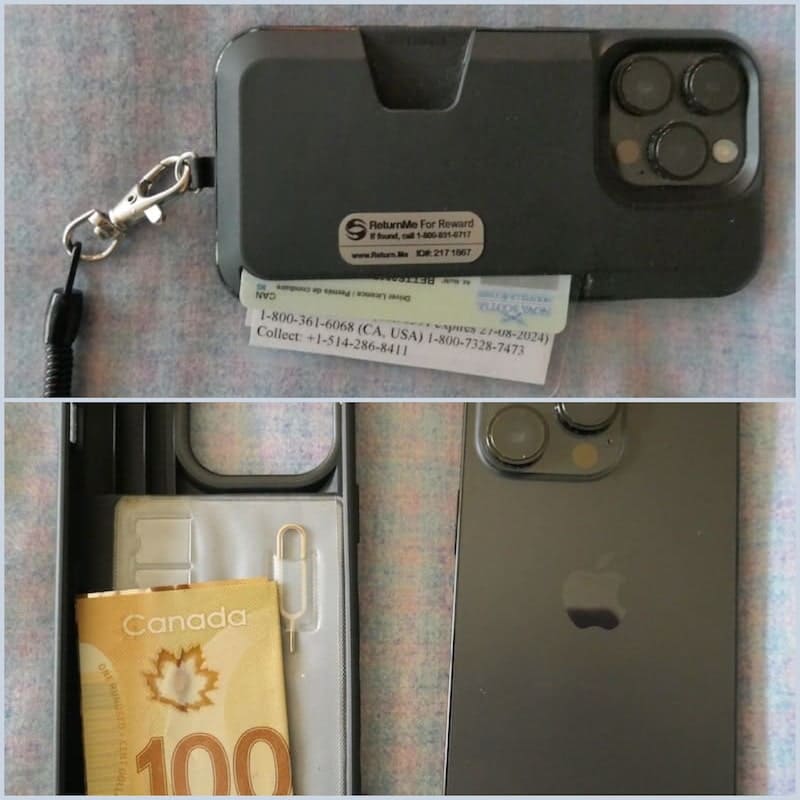
- If necessary, carry some cash in currencies from departure and arrival countries for airport snacks and getting from the airport to your accommodation. Banknotes and coins of different currencies need to be separated. It’s a major inconvenience when they’re not. I create currency sleeves from page protectors for banknotes and carry a couple of zip-top craft bags for coins.
- Keep an emergency cash stash in places not easily discoverable by someone rummaging through your stuff. This might include a hidden pocket in your bag or a ‘diversion safe,’ a repurposed empty container such as lip balm or travel-sized deodorant.
- Make a laminated emergency contact card for telephone numbers of your ICE (In Case of Emergency) contact person, financial institutions, emergency medical insurance administrator, and consular services. Slip one in your wallet, another in your passport sleeve, and one in each bag. Many insurance providers include a wallet card listing the policy holder’s name, policy number, and contact numbers. It’s easy to laminate using a pack of self-laminating cards.
- Carry laminated copies of your passport information page. For dual passport holders, make back-to-back copies. Place one in each bag in readily accessible locations. The actual passport will need to be presented at border services, but there are many occasions when a laminated copy is invaluable.
For more information, see How to make a traveller’s emergency contact card in 5 easy steps and 9 Simple reasons to carry laminated copies of your passport.
3. How will you carry travel documents and booking confirmations?
Electronic or paper? Both have their advantages and disadvantages. Keeping a phone charged and ready to present on demand can be more onerous than packing the phone away and relying on a paper boarding pass. If your checked bag doesn’t arrive at your destination and you’ve lost the boarding pass with the airline’s checked baggage receipts attached, it may be challenging to convince the airline that your bag exists when the airline says it doesn’t (true story). So, what is the best way to carry your travel documents?
For me, it’s a hands-free document holder or crossbody purse with an adjustable strap. Anything with zippered compartments for a passport, boarding passes, printed itinerary, and trusted traveller card does the trick. For a lightweight option, the online marketplace Etsy has many listings for small, zippered neck pouches. My lightweight travel organizer from KapomCrafts at Etsy weighs only 43 g / 1.5 oz. For an anti-theft choice with built-in RFID technology, the Pacsafe Daysafe Anti-Theft Tech Crossbody Bag (127 g / 4.5 oz) accommodates a passport, phone, minimalist wallet, face mask, and boarding passes. For something a little larger, the Osprey Ultralight Shoulder Satchel weighs just 104 g / 3.6 oz. All of these can be hidden under outerwear and except for security screening, worn throughout the journey.
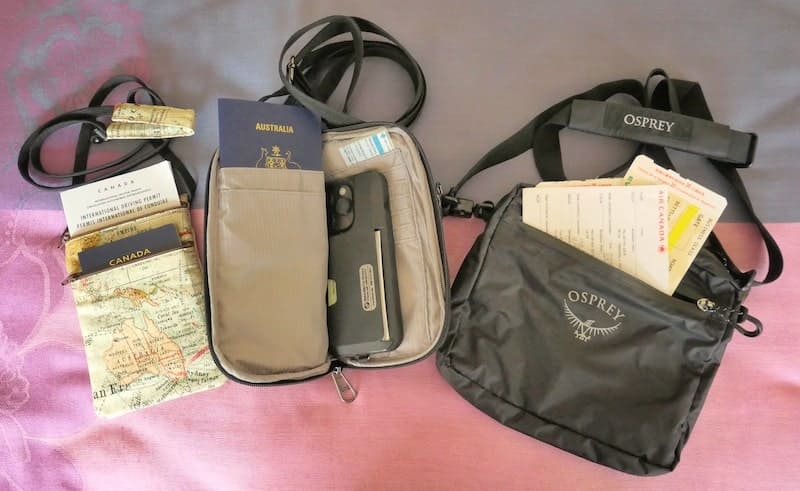
Travel with as little paper as possible. Lots of paper adds weight. Exceptions might be a printed itinerary and printed boarding passes. Carry them in a document holder or an outside pocket of a packable purse. An itinerary can be used to jot down information such as aircraft seating configuration and in-flight amenities obtained from online sources such as AeroLOPA. List airport lounges and their locations. Include directions on arrival (e.g., where to catch the airport shuttle, the name or number of the metro line, walking directions from transit to accommodation, and the address of where you’ll be staying).
Another option is to store travel bookings in an itinerary management app. My app of choice is the free Kayak app with its ‘Trips’ feature.
For more information, see My favourite itinerary management app.
4. Make your personal item double as your day bag
Can your personal item serve as your day bag? If so, it means one less bag and elevates your chances of not having to check your luggage.
- It needs to meet an airline’s size and weight restrictions. As a general guide, aim for measurements of 9 x 10 x 17 inches / 22 x 25 x 43 centimetres. Depending on the airline, weight limits vary between 7 kg and 10 kg (or no limit) for a personal item. I keep a list in the Notes app on my phone and check if there have been any changes to the requirements of the airlines I’ll be using on the next trip.
- It’s comfortable enough to wear or carry for many hours, packed with what you need to enjoy the day at your destination. This might include a phone, water bottle, clothing layers, first-aid supplies, comfort pack of essentials, camera, and a travel umbrella or rain jacket.
- My choice of combined day bag and in-flight personal item varies and will usually be influenced by the destination, season, and type of activities. If it’s the wet season at my destination with daily torrential showers, my packable Osprey Ultralight Dry Stuff Pack will make the cut. If a crossbody bag is a better fit for daily activities, I’ll likely choose my Travelon Anti-Theft Active Tour Bag.
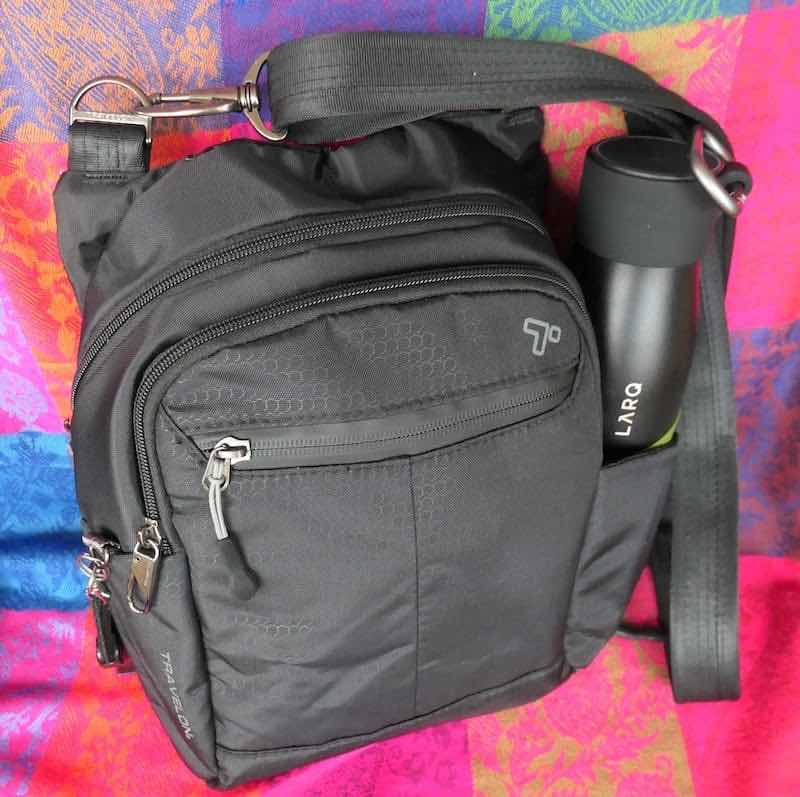
- Some bags offer anti-theft features as part of the design. However, there are adaptations you can introduce to protect your stuff and make you less vulnerable to theft.
For ideas, see Stop pickpockets with this comprehensive assortment of anti-pickpocket gear.
5. Set up your personal item/day bag
Undoubtedly, there will be items deserving a permanent place in your personal item/day bag. While not an in-flight essential, I like to attach a safety whistle (JetScream Floating Whistle) and personal alarm (Sabre) to a crossbody purse. I’ll find a place for a slim pen (Zebra Mini Ballpoint), travel pack of bamboo tissues, soap leaves, a pocket shopping bag, a mini rechargeable flashlight (Olight I1R 2 Pro), an AirTag in a holder. and a small roll of TUMS.
- Does the internal security of your bag need a helping hand? If so, one option is to add a few attachment points such as plastic O-rings or D-rings sewn into the seams. Many bags come with clips to attach keys or other items. These can be handy for attaching items needing an extra layer of security. For example, a retractable coil with lobster claw clasps at both ends can be hooked to a tether tab in a phone case and an attachment point in a phone or pocket. The retractable coil lengthens, allowing you to use your phone while still tethered to your person.
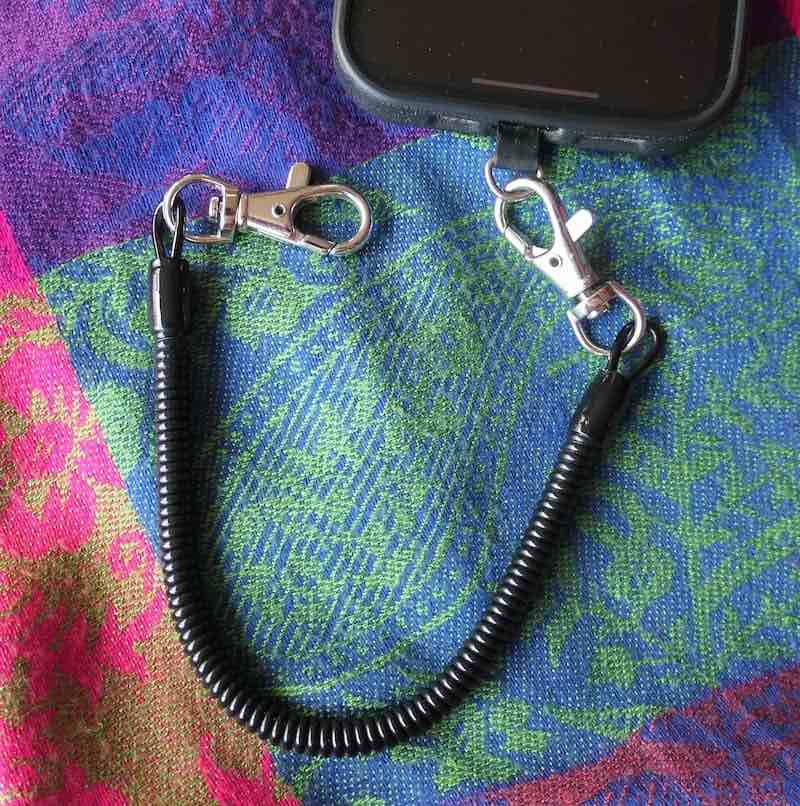
- Find a place for a pocket shopping bag. A pocket shopping bag is so functional it deserves a permanent place in a combined day bag/personal item. It will be handy if you’re likely to shop on airport layovers or make duty-free purchases.
- For external security, consider attaching a TSA-approved lock or a couple of lightweight cables to zipper pulls.
- If your bag has dangling straps, pick up some Web Dominators and they’ll dangle no more.
For more information on these handy travel aids, see Tame dangling straps with Web Dominator.
- In case you’re separated from your personal item, ensure it has an external luggage tag with your name, email address, and telephone number. I like small metal tags with a sturdy keychain cable. A Bluetooth tracker such as a Tile Mate or AirTag adds an extra layer of security. Slip the tracker in a case with a key chain for clipping to an attachment point inside your bag.
See Avoid losing your luggage: tips on tags, trackers, and other tools.
6. Packing organizers are an asset
Packing organizers, such as zippered cloth or reusable zip-lock pouches, help bring order to a bag. This can lead to a faster trip through secondary screening. They also protect their contents and make it easier to find things by touch. If the pouch has an attachment point, it can be tethered to internal bag hardware to improve security for more valuable items.
- For example, place noise-cancelling in-ear headphones and its charging cord in their own pouch. If they’re wired, you may need a lightning-to-jack adapter to connect to your Apple device. If they operate by Bluetooth, an adapter such as AirFly allows a connection to the aircraft’s entertainment system if a 3.5 mm audio jack is required. Whatever your setup, you’ll appreciate having what you need to access various media. Place all related items in a single pouch.
- A repurposed Altoids tin or zippered pouch can house a small travel first-aid kit.
- A ‘comfort pack’ could contain deodorant, tissues, tablet towels, soap leaves, hydrating mist, lubricant eye drops, nasal decongestant, pressure-reducing ear plugs, disinfecting wipes, hand sanitizer, moisturizer, lip balm, and a spare panty liner. When choosing tissues, a travel pack of bamboo tissues is an eco-friendly choice. Compared with their wood-pulp counterparts, they’re free of chemicals and break down faster. The three- and four-ply travel packs are handy for washrooms without toilet paper.
- A small pillbox is ideal for medication, probiotics, and vitamins. These, and others, make it easy to find stuff by touch, offer a measure of protection, and prevent items from roaming free in your bag.
For ideas, see
- How to pack small things in your travel bags
- Create a travel comfort pack for easy access to self-care essentials
- Travel with tablet towels: a multipurpose essential every traveller should pack
- No soap? No problem travelling with soap leaves
7. Do you need a packing list for your personal bag?
If necessary, create a packing list for your personal item. What will you pack in that bag, and which liquids and gels will you need during the flight? Getting stuff out of a standard carry-on bag in the overhead locker is a major inconvenience for you and other passengers. Items such as hand lotion, hand sanitizer, and lip balm can be moved to a personal item after passing through security. However, on recent trips in 2023, I found that removing a 3-1-1- bag is no longer required, and small containers (less than 100 ml) of liquids in a purse passed the scrutiny of screening systems.
8. Choose what you wear with care
- When choosing shoes and clothing, consider safety, comfort, and convenience.Compression socks are a must for long-haul flights. They help increase circulation and reduce the risk of swelling or deep vein thrombosis (DVT). They’re as essential for young, healthy, and fit individuals as they are for older travellers or those with circulatory issues.Also, socks are better than bare feet if you need to remove your shoes during security screening.
- Accidents are rare, but it doesn’t hurt to mitigate the risks. Most aviation accidents happen during takeoff or landing. Choose comfortable shoes that can be worn for the entire flight or slipped on and off easily to visit the washroom or go for a walk. I like AllBirds Wool Runners because they’re breathable, and the soft fabric expands to accommodate minor swelling. With the laces loosely tied, they’re easy to slip on and off during the flight.
- If you choose to wear (rather than pack), hiking boots, you’ll likely need something more comfortable to wear during the flight.
- Most people like to liberate their feet from shoes while recognizing that airline floors are filthy. Occasionally, I’ll pack a pair of lightweight, non-slip grip socks to wear over my compression socks. However, they’re not a wise choice for visiting the bathroom.
- For comfort, wear loose clothes and pack additional lightweight layers. Anything in merino is a good choice. Avoid clothing or accessories with metal studs or buckles that will trigger security systems.
- Take advantage of pockets in clothing. Choosing between ‘wear comfortable clothing’ or ‘wear your heaviest items’ is easier if you can do both. In this respect, pockets are your friends. Travel pants with one or two cargo pockets or leggings with pockets are great for carrying miscellaneous items. Look for cargo pants with internal pockets and a discreet zipper that is hardly visible – not the bulky external pockets that give the impression you’re going on safari.
- A travel vest from SCOTTeVESTor a jacket from Clothing Arts can carry a lot of stuff! This type of clothing has the added benefit of zippered internal pockets, perfect for airport screening. Stow your stuff, ensure pockets are zipped, place it in a bin on the conveyor belt, and pick it up at the other end. I’ve carried as much as 1.4 kg / 3.1 lb of stuff in my Clothing Arts Cubed Travel Jacket or SCOTTeVEST Lightweight Travel Vest.
9. Pack to stay healthy and comfortable
- A pashmina adds a touch of flair to a travel outfit. It can be indispensable as a shawl to deal with fluctuations in temperature. My pashmina saved me from a torturous bus ride from Marrakech to Tangier when the air-conditioning was cranked up so high that it was unbearably cold. For such a lightweight item, it’s remarkable how it offered warmth. Another advantage is that it can hide a crossbody purse while sleeping.
For more information, see Always pack a pashmina: one of the best multipurpose items in a travel bag.
- I always pack a full-zip mid-weight merino sweater in case of cooler temperatures. One with a hood allows me to cozy up and avoid contact with the headrest.
- Storing a hoody or other clothing layers in a packing organizer or pillowcase offers protection and serves as a makeshift pillow. I’m yet to find an inflatable or memory-foam travel pillow that’s worth the space (and weight) it consumes when I’m not flying. My lightweight, travel-inspired pillowcase cover from the online marketplace Etsy can also be stuffed with an airline pillow for back or neck support. If you prefer a C-shaped or U-shaped neck pillow, or a bendable, twistable pillow, there are several lightweight covers that can be stuffed with items of clothing. Like inflatable travel pillows that can hold as much or as little air as you like, the inside of a stuffable cover can be lightly or tightly packed. Where the stuffable pillow has the edge is that items can be moved to different parts of the cover depending on where support is most needed. Some airlines don’t count travel pillows as part of a passenger’s carry-on allowance so it’s an opportunity to carry extra stuff.
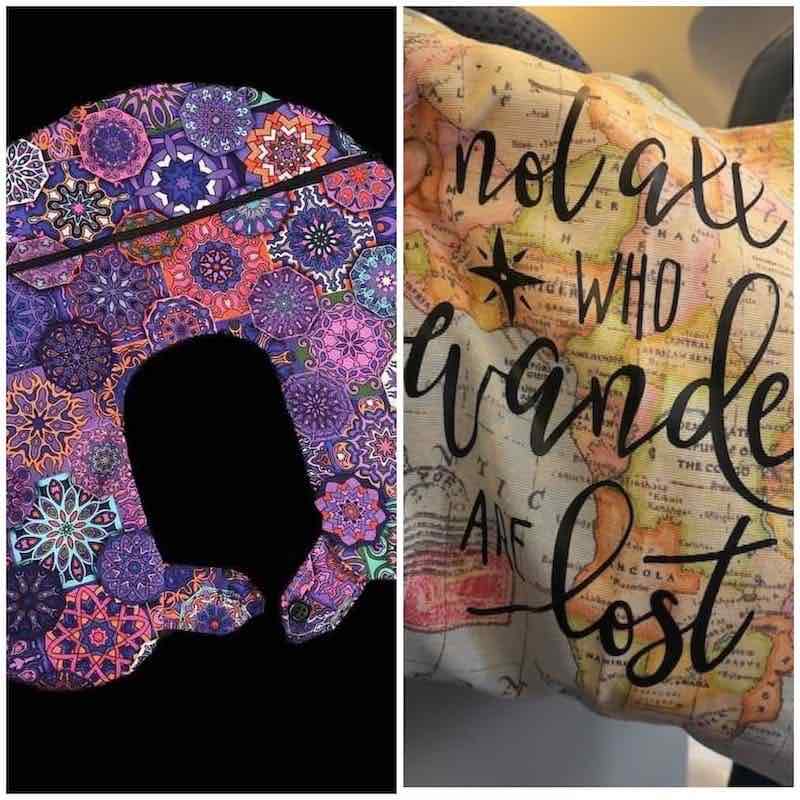
- Pack an eye mask if light from a window, overhead lights, or nearby reading lamps prevents you from sleeping. A contoured sleep mask with memory foam allows eyes to move freely under the soft fabric. Wide coverage and an adjustable strap conspire to block out light. completely. Mine is from Tepech and works beautifully. A beanie/toque or Buff pulled over the eyes could serve a similar purpose for some people.
- If music, guided meditation, a podcast, or audiobook storytelling aren’t good sleeping companions, pack some noise-reducing earplugs.
- In various Facebook travel groups, several people have described a foot hammock as a game changer. Some airlines have banned hanging footrests as tray tables are not built to accommodate them and they’re a health hazard for passengers entering or exiting the tight space in a row of seats.
- Always carry a face mask. There will be times, such as sitting near a passenger coughing and sneezing and not wearing a mask.
- Planes are unsanitary places. The tray tables, seat belts, headrests, window ledges, shades, and armrests aren’t clean. The pandemic may have improved sanitizing procedures, but a few disinfecting wipes give your space for the next 15 hours an extra clean.
- Use hand sanitizer often and avoid touching your face. Have you flipped through the in-flight magazine? If so, sanitize. Did you check the safety card in the seatback pocket? If so, sanitize. If you’ve touched the latch on the overhead locker, sanitize. Sanitize often, especially before touching your face or food. When visiting the washroom, wash your hands with soap and water for at least 20 seconds. Use a paper towel to open the door and then sanitize your hands upon returning to your seat. Multiple studies have revealed that areas touched in the bathroom (e.g., door latch, sink taps, toilet flush) are among the ‘germiest’ spots on a plane.
- The air is dry at 30,000 feet. It doesn’t take long for nasal passages, eyes, lips, and skin to feel the effects. Carry a stick of lip balm. For a hydrating facial mist, I love Mario Badescu with aloe, herbs, and rosewater. Decant your favourite liquid moisturizer into a small container for in-flight use. I also carry the versatile Cococare 100% Cocoa Butter Stick. It’s a natural moisturizer with a delectable fragrance that can be applied to any dry area, including the face, neck, lips, and hands. An added advantage is that it doesn’t leak. Lubricant eye drops are essential if you spend many hours watching a movie, working on your device, or reading printed materials.
- Many people experience ‘airplane ear’ during takeoff and landing and seek relief by yawning and swallowing. These can be complemented with EarPlanes, pressure-filtering earplugs. With a noise-reducing rating of 20dB, they could be used as earplugs throughout the flight. Airplane ear risk is increased with a common cold, hay fever, or sinus infection. If so, use a nasal decongestant spray 30 minutes to an hour before takeoff and landing. A friend swears by Afrin.
- It’s possible you may have to deal with odours from stinky food, smelly shoes or feet, a dirty diaper, cigarette smoke on clothing, the toilet, or perspiration or foot odour from another passenger. It may not be possible to change seats so pack something to mask the smell. I’ve found rubbing a small amount of Tiger Balm or Mentholatum (anything with camphor and menthol) under my nose works. Or pack a small roller of essential oils such as lavender and eucalyptus and apply to your body, face mask, or travel pillow.
- For immune support, I pack a few sachets of Ener-C Effervescent Powdered Drink Mix (cranberry is a favourite), Sambucol Black Elderberry Pastilles (with zinc, Vitamin C, and honey), and oregano capsules. There’s no scientific evidence that these are effective. Still, my experience is that they help ward off a common cold or lessen its effects. I take them before, during, and after the flight.
- For a hydration booster, I like the portability of a tube of Nuun Sport hydration tablets. Liquid IV is a very popular choice in a powder.
- To maintain gut health, my daily probiotic while travelling is Saccharomyces boulardii. I’ve tried products from AOR and NOW and both have worked well. Does a probiotic work? For someone prone to Travellers Diarrhea, it works for me. Choosing the right probiotic takes trial and error. For example, a friend swears by Health Balance Complete Probiotic with 8 probiotic strains and 30 billion active cells. She suffered sudden irritable bowel attacks that stopped once she switched to this product. It’s also available from Costco.
- Staying hydrated is critical. Fill your refillable water bottle after clearing security. One with a wide mouth is easier and more hygienic to fill. I particularly like the self-cleaning LARQ that sterilizes water from trusted and natural sources. However, with its active loop and sleeve, it’s heavy for a water bottle (325 g / 11.4 oz). For those occasions when I want something lighter, my foldable Vapur Eclipse (23 oz / 0.7 l) gets the job done. It weighs 38 g / 1.3 oz.
- A collapsible cup makes it easier to refuse in-flight plastic cups and bottles. It’s also preferable to using a refillable water bottle for mixing tablets or powders for immune support or a hydration boost. My Stojo Pocket Cup (12 oz / 355 ml) weighs 143 g / 5.1 oz.
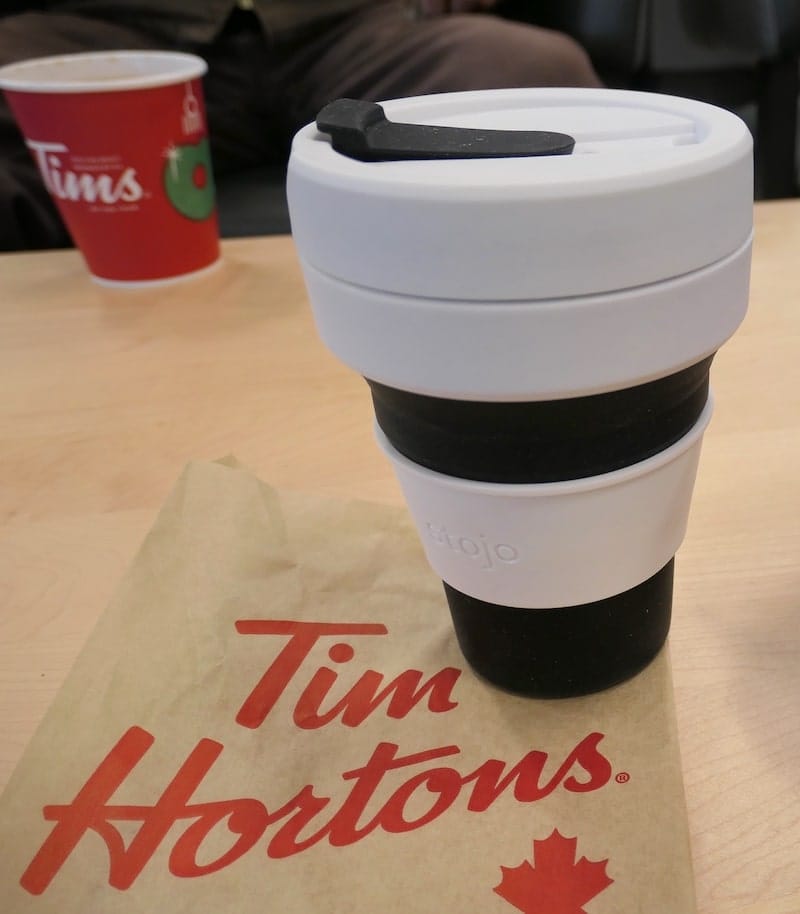
- A small travel first-aid kit has a permanent place in my personal bag and day bag. A paper cut, motion sickness, diarrhea, heartburn, or headache can strike at any time, and it helps to have remedies close at hand. It needs to be customized with your specific needs in mind.
- Educate yourself on sleep-aid medication, or better still, consult a healthcare professional. Some people advocate taking melatonin, which works differently for different people. Sleeping pills might help you sleep on a flight, but will it compromise your ability to cope with an arrival routine and safely find your way to your accommodation?
10. Ensure access to devices
Back in the day, my regular trips from Canada to Australia to visit family were more than forty hours from Halifax to Brisbane. The aircraft’s entertainment system invariably involved a small overhead screen that may or may not have been easily seen depending on where I was seated. Everyone watched the same movie. The two paperback novels I always packed helped me get through those flights. Today, our devices offer more pleasurable alternatives.
- Most long-haul aircraft have power outlets, but this is never a guarantee. It could be the same with layovers; connection times might not be long enough to charge a device or outlets might not be available or working. That was the case on my last trip – not a single outlet worked at a new terminal at Charles De Gaulle in Paris, and I was only half-way home! Plan to board with fully charged devices and a fully charged external charger/power bank. A 10,000mAh unit represents the sweet spot between getting the job done and not being too heavy. My TG90 with built-in charging cords means several devices can be charged at the same time. It clocks in at 208 g / 7.3 oz.
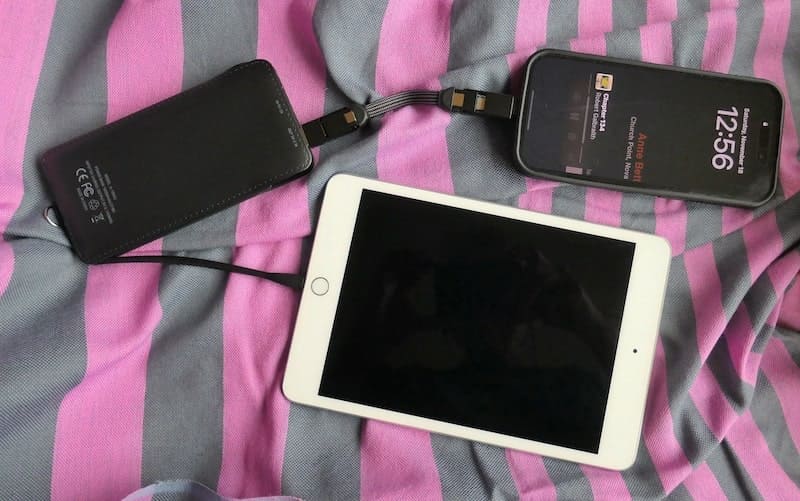
- For layovers between flights, pack the necessary adapter. I like a multi-port USB charger with interlocking international adapters and USB-A and USB-C ports. My Lencent 45W Multiple USB Wall Charger means leaving the various charging bricks at home and just packing charging cables.
- With so many different connectors on devices and cables (USB Type A, USB Type C, Lightning, and Micro USB), a 6-in-1 charger small enough to attach to a keychain can undoubtedly earn its keep. That was the case on my last trip with the Rolling Square inCharge X.
- When I travel with a laptop, it now goes into dry bag. What could have been a very expensive lesson happened on a short flight from Halifax to Montreal. When I landed, I grabbed my under-seat personal item that was soaked. A passenger in front had dropped a water bottle and failed to retrieve it. I’ve also read about the destruction wreaked by leaking toiletries. With so many liquids on flights, a dry bag offers an extra level of protection for valuable electronics.
To learn more about these versatile items, see 10 Reasons to travel with dry bags.
- Increasingly, airports, hotels, and other public places, have USB charging ports. A USB data blocker offers protection when using public USB ports.
For more information, see Do you need a USB data blocker? You do if you use public USB charging stations.
- A VPN (Virtual Private Network) is a necessity for using public Wi-Fi safely. It encrypts your data, so it’s secure when accessing email or financial information or paying for online bookings. It enables you to connect to a server in another country. It also means access to geo-blocked streaming services or banned sites in certain countries. I use NordVPN.
See Why you need a VPN when you travel.
11. Always pack your own entertainment
A variety of entertainment is critical to surviving a 15-hour flight. A phone and tablet can carry music, podcasts, movies, TV shows, books, audiobooks, games, and various travel aids such as language basics and a journal. Or bring a print book and magazine. Having a variety allows you to switch from screens to print, and giving your eyes a rest with an audiobook, podcast, or music. Relying on the airline for in-flight entertainment is never a good idea. Some flights don’t have any, or seats where it’s not working. Some airlines charge for movies or require downloading an app to access their in-flight system.
- Pack a headphone splitter if you’re sharing your device with a travelling companion. The Belkin Speaker and Headphone Splitter connects two sets of wired headphones.
- If you enjoy games, Too Many Adapters has some suggestions.
- Squeeze extra value out of your Netflix and Spotify Premium subscriptions. Download movies and synch your playlists for offline access.
- Hours of screen time can be hard on the eyes, so a printed book or magazine is an alternative. It doesn’t need a battery or charging cable!! The Kindle Paperwhite has a glare-free screen with the added advantage of working in bright sunlight at your destination. Some travellers find calm and pleasure in a travel-themed colouring project.
- A portable reading light avoids the need to turn on an overhead light for writing projects or reading printed materials. I like the Grifin 9 LED Rechargeable Book Light because it’s lightweight, packable, has a flexible neck and several levels of brightness, and its sturdy clip attaches to a book or table.
- A multi-angle holder for an e-reader, phone, and tablet is a hands-free in-flight option. Use it during transit, while dining, videoconferencing, or performing other tasks. The Labilus is one of the lightest portable stands on the market at 64 g / 2.2 oz. It’s foldable for packing and adjustable for viewing in portrait or landscape mode. Anti-slip silicone pads stabilize and protect the device.
- It can be an ideal time to get some work done. You’ll be unavailable by phone and perhaps disconnected from the internet. The MS Word app provides access to files stored in Dropbox. Tag those you want to edit, and the app will upload them to Dropbox when you’re back on Wi-Fi.
- Or use an app to brush up on language basics.
- Destination-based novels and guides can help with last-minute orientation and travel planning.
- Downtime on a flight can be a perfect opportunity to cull, edit, and categorize photos. A small camera connector is a permanent fixture in my purse to quickly transfer photos from my pocket camera, a Panasonic Lumix DC-ZS200, to my iPad mini without needing Wi-Fi. Snapseed is my go-to photo-editing app. It works brilliantly! Culling and editing throughout a trip make the task more manageable.
- If you like to journal, keep notes, or record captions of photos for a post-trip project, you might want to carry a travel journal. If the digital variety is for you, a travel diary app might meet your needs. My preference is the kind of distraction-free space found in MS Word or Google Docs. For inspiration, I have a separate document with a variety of travel journal prompts collected from across the internet.
- Headphones are essential for enjoying audio and video entertainment or playing meditation music to help sleep come easier. They serve another purpose as earplugs, drowning out the sounds of crying babies, loud talkers, snoring passengers, and folks who have an inadequate seal on their earphones and jack up the volume on their entertainment system. They also signal to neighbours that you’re not interested in conversation. I prefer the in-ear noise-cancelling variety. They’re lightweight, comfortable for sleeping, and take up much less space than the over-head variey. I use the wired Bose QC 20; I find the earbuds offer a better seal than my AirPods Pro, and I don’t need a connector such as AirFly. Besides, if a wired earbud pops out of an ear, it remains physically connected to the unit.
12. Pack some snacks
- A packed snack is an insurance against unappetizing and costly in-flight snacks. Avoid anything salty, refined, or processed, and it’s a good idea to skip nuts in case someone nearby has severe allergies. Seeds, dried fruit, and dark chocolate are my go-to staples. LÄRABAR or Clif bars are a great choice.
- The right candies can serve other needs. Sucking on a candy stimulates swallowing that helps open the eustachian tubes to better deal with the changes in air pressure during ascent and descent. Mints can be useful as a breath freshener. For motion sickness, indigestion, or an upset stomach, ginger chews have proven to be effective.
13. Packing to feel human
- A toothbrush, toothpaste or a few toothpaste tablets, and floss will keep your breath fresh and help brush away the grunge of long-distance travel. If brushing your teeth in an airplane washroom holds no appeal, carry a travel pack of mints, breath strips, or chewable mouthwash tablets.
- One or two reusable panty liners and a spare pair of lightweight panties can help you feel fresh at the end of your journey. Panty liners are easier to change in an airplane washroom or airport toilet. Mine are from the online marketplace, Etsy but there are several choices of bamboo charcoal reusable panty liners at Amazon.
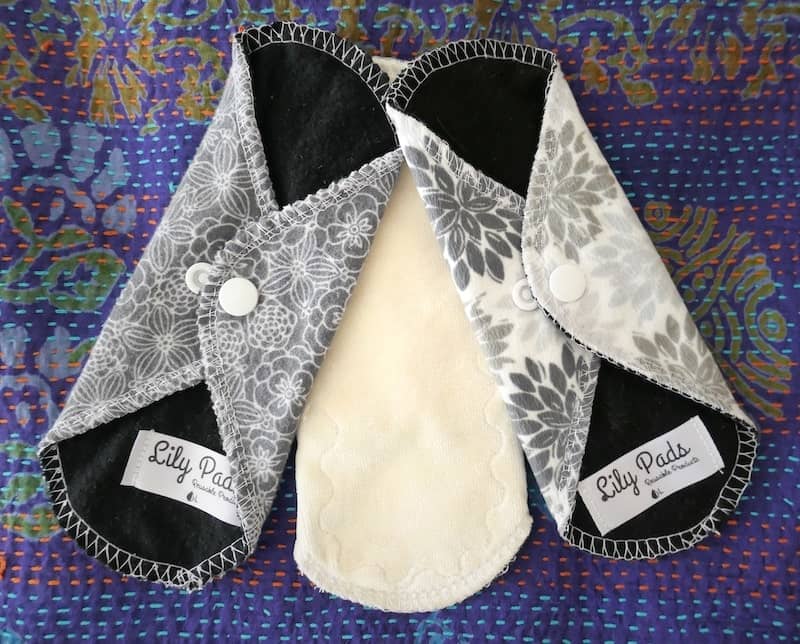
- You’ll feel fresher by changing into a clean shirt, but merino holds up exceptionally well and is an excellent choice for long-haul travel. Pack a spare pair of socks if you’re keen to liberate your legs from compression socks after you land. Again, merino is fantastic for its wicking and odour-control abilities. Travellers with checked luggage tend to pack an entire change of clothes in case of delayed and missing luggage.
- Brush or comb? There are folding varieties that take up less space. Many have a built-in mirror.
- Consider packing dry shampoo if a long-haul flight is likely to result in a bad-hair day. Dry shampoo absorbs oil and contains styling ingredients that add volume, thickness, and texture. There are aerosol sprays, but a powdered shampoo can be just as effective (and more travel-friendly). My favourite is Bumble and Bumble Prêt-a-Powder, available in a travel-sized container (0.5 ov / 14 g).
14. Some miscellaneous suggestions
- If you rely heavily on reading glasses, a pair of ThinOPTICS is insurance against lost or broken glasses. They’re paper thin and take up no space to speak of. Mine weigh only 4 g / 0.2 oz. With the protective case, they weigh 8 g / 0.6 oz. Also, pack a protective case for glasses to store them safely when not in use.
- A lens wipe or microfibre cloth can be handy for cleaning glasses or a camera lens. I use a microfibre pouch obtained from my optician. It doubles as a protective pouch for my pocket camera.
- It takes a skinny pen, as light as they come, to complete customs and immigration forms (in blue or black ink). A Zebra Mini Ballpoint Pen ( 8 g / 0.3 oz) deserves a permanent place in a travel purse. You may be asked for the address of where you’re staying, so load this on your phone beforehand. Also, write it on your printed itinerary. You may need help finding it at your destination, and handing your phone to a stranger is never a good idea.
- Consider carrying some business cards. You’ll meet some interesting folks, and you may want to stay in touch. A business card is a quick and efficient way to exchange contact information.
- A mini flashlight has a permanent home in my travel purse. It helps illuminate difficult-to-see items or search for something that may have fallen on the floor or is deep inside a bag. Sure, there’s a flashlight app on your phone, but sometimes a flashlight is the better option. I like the compact size of the Olight I1R2 Pro, 180 lumens. It’s rechargeable and can be easily attached to a keychain.
Other tips
- Aisle or window seat? Each one has its advantages. I like a window seat for resting against the wall, but I prefer the convenience of an aisle seat to go for regular walks. Paying for seat selection is an option or checking in online as soon as it opens.
- Get into the habit of returning an item such as a boarding pass, eyeglasses, wallet, or headphones to the same compartment or packing organizer each time. Take something out and put it back after use. It’s a formula for losing things less often. Skip the seatback pocket. Reports of dirty diapers and other unpleasant stuff are true. The inside of your bag is a healthier environment for your possessions. Besides, you may be jet lagged at the end of the flight and more likely to leave something behind if it’s not in your bag.
- Many credit cards offer free lounge membership and complimentary passes. If your existing credit cards don’t have this benefit, research those that do. You may find one or more attractive credit card promotions with the annual fee waived in the first year. My last trip involved most segments in business class using frequent flyer points but there were two occasions when I appreciated having access to the Priority Pass/Visa Airport Companion Lounges in Cape Town and Kasane, Botswana. Complimentary food and drinks and comfortable seating help make airport layovers enjoyable.
- Make a pre-trip to-do list that includes tasks associated with in-flight and in-transit enjoyment. These include things such as signing up for a free Audible subscription, compiling Spotify playlists, updating a lounge membership app with complimentary passes, downloading the respective airline apps, and fully charging all devices.
If you found this post useful, please share it on your favourite social media channel by clicking on the respective button(s). In addition, it would be wonderful to have your thoughts in the comments. What have I missed? What else do you include as carry-on essentials on long flights? What are your tried-and-true products you always pack?
Care to pin for later?
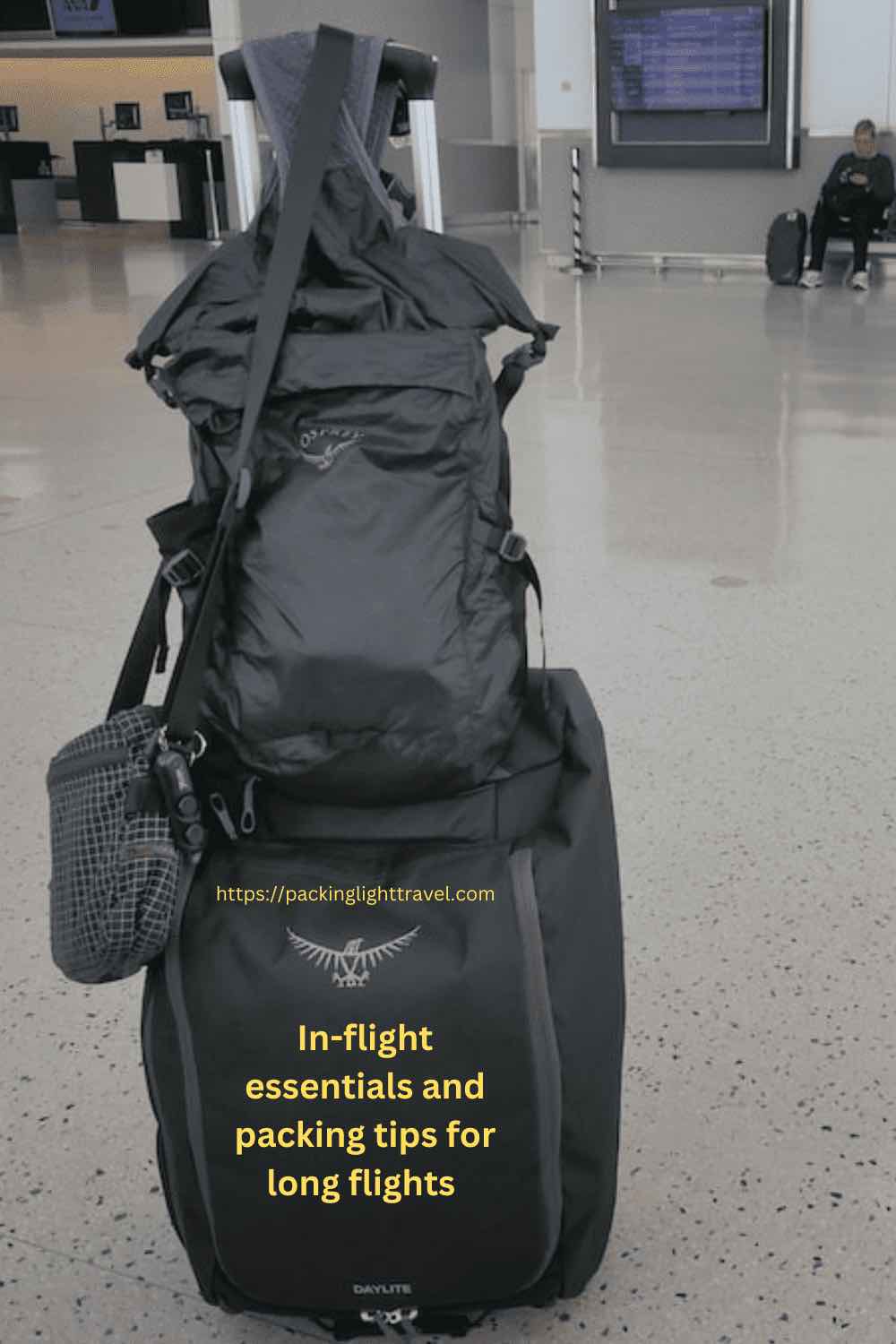
Some of the links in this post are affiliate links. This means that if you click on a link and buy something, you don’t pay more but this site earns a small commission that helps with the costs of maintaining Packing Light Travel. Thank you for your support.

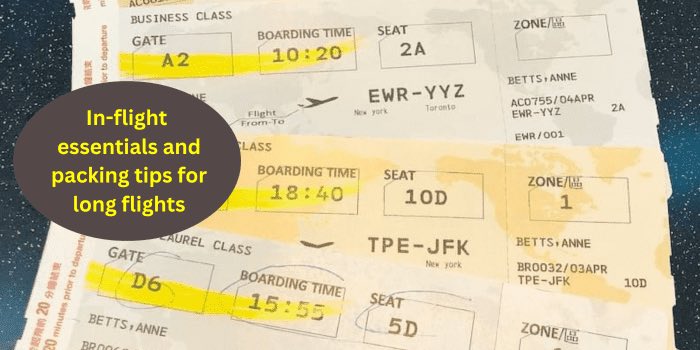




Trackbacks/Pingbacks